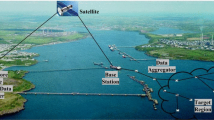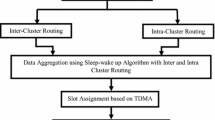Abstract
The distinctive characteristic of the UWSNs environment presents novel challenges for network communication. Due to the harsh environment, extreme energy loss is carried out and nodes of networks expire early which reduces the life of the network. Cluster-based strategies can support UW communication because instead of all nodes only the cluster head (CH) collect and transmit data to the sink, rather than every node sending data by itself. Round base clustering strategies work in three phases: cluster setup, steady-state, and data transmission to the sink. The first phase only provides a setup and does not take part in communication while being a contributor to network energy consumption. Many of the researchers have proposed cluster-based protocol for underwater communication and considered it cursorily or not cogitate it. This paper presents the simulation and analysis of this cluster setup phase and shows that the cluster setup phase is the main phase of the clustering strategy and consumes the network energy called surplus energy consumption. It is determining by the simulation that a maximum of 13.2% network surplus energy consume during thirty three percent of cluster head formation. It is also shown that 5% CH formation is most suitable for the network to minimize surplus energy to 9.5%.





Similar content being viewed by others
Data availability
All data generated or analyzed during this study are included in this article.
Code availability
Code will be available on request.
References
Manjula, R. B., & Manvi, S. S. (2011). Issues in underwater acoustic sensor networks. International Journal of Computer and Electrical Engineering., 3(1), 101.
Akyildiz, I., Pompili, D., & Melodia, T. (2005). Underwater acoustic sensor networks: Research challenges. Ad Hoc Networks, 3, 257–279.
Nayyar, A., Puri, V., & Le, D. N. (2019). Comprehensive analysis of routing protocols surrounding underwater sensor networks (UWSNs). In Proceedings of ICDMAI, Volume 1. https://doi.org/10.1007/978-981-13-1402-5-33
Akyildiz, I., Pompili, D., & Melodia, T. (2004). Challenges for efficient communication in underwater acoustic sensor networks. ACM Sigbed Review, 1, 3–8.
Sozer, E. M., Stojaovic, M., & Proakis, J. G. (2000). Underwater acoustic networks. IEEE Journal of Oceanic Engineering, 25, 72–83.
Wang, P., Zheng, J., & Li, C. (2009). Cooperative fault-detection mechanism with high accuracy and bounded delay for underwater sensor networks. Wireless Communications and Mobile Computing, 9, 143–153.
Omeke, K. G., Mollel, M. S., Ozturk, M., Ansari, S., Zhang, L., Abbasi, Q. H., & Imran, M. A. (2021). DEKCS: A dynamic clustering protocol to prolong underwater sensor networks. IEEE Sensors Journal, 21(7), 9457–9464.
Yan, H., Shi, Z. J., & Cui, J. H. (2008). DBR: Depth-based routing for underwater sensor networks. In International conference on research in networking. Springer: Berlin/Heidelberg, Germany (pp. 72–86).
Mazinani, S. M., Yousefi, H., & Mirzaie, M. (2018). A vector-based routing protocol in underwater wireless sensor networks. Wireless Personal Communications, 100(4), 1569–1583.
Jornet, J. M., Stojanovic, M., & Zorzi, M. (2008). Focused beam routing protocol for underwater acoustic networks. In Proceedings of the 3rd ACM international workshop on wireless network testbeds, experimental evaluation and characterization (WuWNeT’08) (pp. 75–82). San Francisco, CA, USA.
Ayaz, M., & Abdullah, A. (2009). Hop-by-hop dynamic addressing based (H2-DAB) routing protocol for underwater wireless sensor networks. In International conference on information and multimedia technology (pp. 436–441), Jeju Island, South Korea.
Wahid, A., & Kim, D. (2012). An energy efficient localization-free routing protocol for underwater wireless sensor networks. International Journal of Distributed Sensor Networks 8(4), Article ID 307246.
Wan, Z., Liu, S., Ni, W., & Xu, Z. (2018). An energy-efficient multi-level adaptive clustering routing algorithm for underwater wireless sensor networks. Springer Science Business Media, LLC, part of Springer Nature. https://doi.org/10.1007/s10586-018-2376-8
Ahmed, M., Soomro, M. A., Parveen, S., Akhtar, J., & Naeem, N. (2019). CMSE2R: Clustered-based multipath shortest distance energy efficient routing protocol for underwater wireless sensor network. Indian Journal of Science and Technology. https://doi.org/10.17485/ijst/2019/v12i8/141788
Ahmed, M., Salleh, M., & Channa, M. I. (2018). CBE2R: A clustered-based energy-efficient routing protocol for underwater wireless sensor network. International Journal of Electronics, 105(11), 1916–1930. https://doi.org/10.1080/00207217.2018.1494323
Zhu, J., Chen, Y., Sun, X., Wu, J., Liu, Z., & Xu, X. (2021). ECRKQ: Machine learning-based energy-efficient clustering and cooperative routing for mobile underwater acoustic sensor networks. IEEE Access, 9, 70843–70855.
Li, X., Fang, S.-L., & Zhang, Y.-C. (2007). The study on clustering algorithm of the underwater acoustic sensor networks. In 2007 14th International conference on mechatronics and machine vision in practice (pp. 78–81). IEEE.
Ilyas, M., Ullah, Z., Khan, F. A., Chaudary, M. H., Malik, M. S., Zaheer, Z., & Durrani, H. U. (2020). Trust-based energy-efficient routing protocol for Internet of things–based sensor networks. International Journal of Distributed Sensor Networks., 16(10), 1550147720964358.
Khan, M. F., Bibi, M., Aadil, F., & Lee, J.-W. (2021). Adaptive node clustering for underwater sensor networks. Jounal Sensors, 21, 4514.
Sahana, S., & Singh, K. (2019). Fuzzy based energy efficient underwater routing protocol. Journal of Discrete Mathematical Sciences and Cryptography, 22, 1501–1515.
Fei, W., Hexiang, B., Deyu, L., & Jianjun, W. (2020). Energy-efficient clustering algorithm in underwater sensor networks based on fuzzy c means and moth-flame optimization method. IEEE Access, 8, 97474–97484.
Liu, G., & Wei, C. (2011). A new multi-path routing protocol based on cluster for underwater acoustic sensor networks. In International conference on multimedia technology (pp. 91–94).
Alhazmi, A. S., Moustafa, A. I., & AlDosari, F. M. (2018). Energy aware approach for underwater wireless sensor networks scheduling: UMOD_LEACH. In 21st Saudi computer society national computer conference (NCC) (pp. 1–5).
Anupama, K. R., Sasidharan, A., & Vadlamani, S. (2008). A location-based clustering algorithm for data gathering in 3D underwater wireless sensor networks. In 2008 international symposium on telecommunications (pp. 343–348). IEEE.
Wan, Z., Liu, S., Ni, W., & Xu, Z. (2019). An energy-efficient multi-level adaptive clustering routing algorithm for underwater wireless sensor networks. Cluster Computing, 22(6), 14651–14660. https://doi.org/10.1007/s10586-018-2376-8
Zhu, F., & Wei, J. (2018). An energy efficient routing protocol based on layers and unequal clusters in underwater wireless sensor networks. Journal of Sensors. https://doi.org/10.1155/2018/5835730
Anuradha, D., & Srivatsa, S. K. (2019). Energy effectual reconfigurable routing protocol (E2R2P) for cluster based underwater wireless sensor networks. Journal of Ambient Intelligence and Humanized Computing, 1–8.
Rizvi, H. H., Khan, S. A., Enam, R. N., Naseem, M., Nisar, K., & Danda, R. B. (2022). Adaptive energy efficient circular spinning protocol for dynamic cluster based UWSNs. IEEE Access. (2022).
Karim, S., Shaikh, F. K., Aurangzeb, K., Chowdhry, B. S., & Alhussein, M. (2021). Anchor nodes assisted cluster-based routing protocol for reliable data transfer in underwater wireless sensor networks. IEEE Access, 9, 36730–36747.
Ovaliadis, K., & Savage, N. (2014). Cluster protocols in underwater sensor networks: A research review. Journal of Engineering Science and Technology Review, 7(3), 171–175.
Enam, R. N., Imam, M., & Qureshi, R. I. (2012). Energy consumption in random cluster head selection phase of WSN. In 2012 IACSIT Hong Kong conferences IPCSIT vol. 30 © (2012). IACSIT Press: Singapore.
Rizvi, H. H., Khan, S. A., & Enam, R. N. (2022). Clustering base energy efficient mechanism for an underwater wireless sensor network. Wireless Personal Communications, 1–17 (2022).
Bouk, S.H., Ahmed, S. H., & Kim, D. (2016). Delay tolerance in underwater wireless communications: A routing perspective. Mobile Information Systems 4, Article ID 6574697, 9 p. https://doi.org/10.1155/2016/6574697
Kularia, Y., Kohli, S., & Bhattacharya, P. P. Analyzing propagation delay, transmission loss and signal to noise ratio in acoustic channel for Underwater Wireless Sensor Networks. In 2016 IEEE 1st international conference on power electronics, intelligent control and energy systems (ICPEICES) 2016.
Funding
The authors received no specific funding for this study.
Author information
Authors and Affiliations
Contributions
Conceptualization: HHR, Dr. RNE, Data creation: Dr. RNE, Formal analysis: HHR, Investigation: HHR, Methodology: HHR, Dr. RNE, Project administration: HHR, Dr. SAK, Resources: Dr. SAK, HHR, Software: HHR, Supervision: Dr. SAK, Dr. RNE, Validation: HHR, Dr. SAK, Visualization: HHR, Dr. RNE, Writing—original draft: HHR, Writing—review and editing: HHR.
Corresponding author
Ethics declarations
Conflict of interest
The authors declare that they have no conflicts of interest to report regarding the present study.
Additional information
Publisher's Note
Springer Nature remains neutral with regard to jurisdictional claims in published maps and institutional affiliations.
Rights and permissions
Springer Nature or its licensor holds exclusive rights to this article under a publishing agreement with the author(s) or other rightsholder(s); author self-archiving of the accepted manuscript version of this article is solely governed by the terms of such publishing agreement and applicable law.
About this article
Cite this article
Rizvi, H.H., Khan, S.A. & Enam, R.N. Energy Consumption in Round Base Clustering for UWSN. Wireless Pers Commun 128, 2245–2257 (2023). https://doi.org/10.1007/s11277-022-10041-4
Accepted:
Published:
Issue Date:
DOI: https://doi.org/10.1007/s11277-022-10041-4




